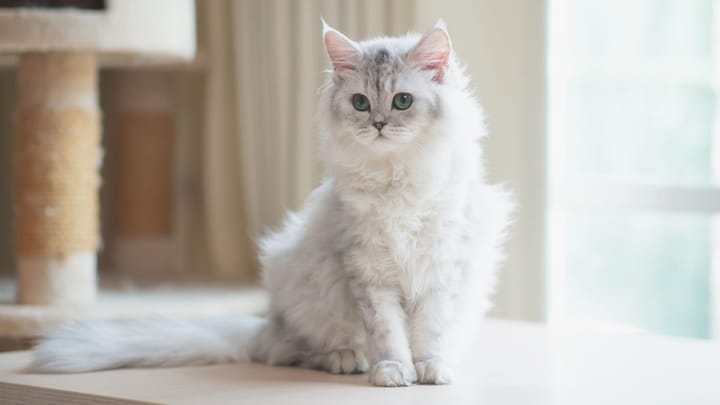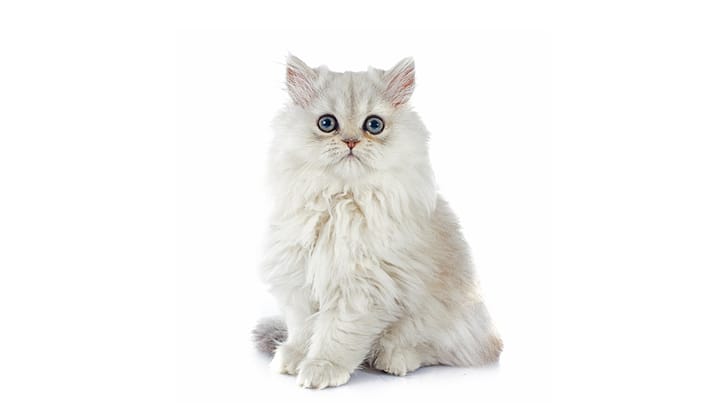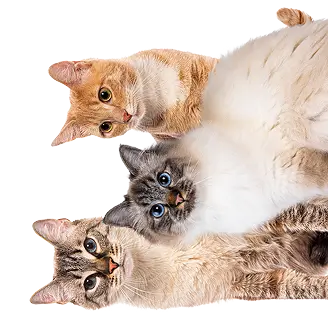Chinchilla Persian
Other name: Silver Persian


Their unique coat is what gave this breed the same name as the chinchilla, a small mammal with unusual fur. Very calm, this is one of the most popular varieties of Persians. In the 18th century, A Silver Persian was embalmed and then exhibited in London at the Museum of Natural History. How could anyone resist their sparkling emerald green eyes? They seduce with their fine and silky fur, with silver or gold highlights.
|
Life expectancy |
The Chinchilla Persian has a life expectancy of between 12 and 18 years |
|
Temperament |
|
|
Adult size |
Female
Between 9 and 10 in
Male
Between 9 and 10 in
|
|
Adult weight |
Female
Between 7 and 15 lb
Male
Between 7 and 15 lb
|
|
Coat colour
The colour of the tipping can be black/seal, blue, grey-slate, lilac, chocolate. The coat of the Persian Chinchilla has a very light base, only one-eighth of the length of each hair is coloured. From the muzzle to the lower part of the tail, through the chest and belly, the hair is entirely white. We find the shade of the colour of "tipping" (tip of coloured hair) on their toes and on the contours of the pink nose. |
Black Brown Blue |
|
Type of coat
They have long, silky and fine fur with a thick undercoat. |
Long |
|
Eye colour
Their emerald green eyes are contoured by the colour of the tipping. One of the characteristics of the Chinchilla Persian is that their eyes turn green at around 7 months old. |
Green
|
There are other types of Chinchilla Persian such as the "Silver shaded", recognised in the seventies, whose "tipping", which represents a third of the hair, is more visible on the coat and more marked on the legs and under the eyes.
There is also the "Golden", which has golden undertones in the undercoat and at the tip of their black tail. This one can be "shaded", one third of the hair being coloured, or "shell", with one eighth of the hair being coloured. These have only recently been recognised, when the appearance of this gene was noted in 1925.
Finally, the Persian Cameo, which is a fully-fledged breed in the United States, but a variety of Chinchilla in France and England. This one sports a coat called "red silver shaded": the base of the hair is silver or ivory and the tip is ginger.
More details about the Chinchilla Persian
Chinchilla Persian: Origins and history
In 1880, an English breeder, Mrs. Vallence, crosses a Persian "smoke" with a "silver tabby" which gave birth to the very first Persian Chinchilla: Silver Lambkin. This breed spread rapidly throughout the kingdom thanks to the Queen's niece, Princess Victoria, who fell in love with it. It was recognised by the British Feline Breeds Register (GCCF) in 1901. The selection process was careful to create the emerald eyes and lighten the coat which, at first, was darker. The Second World War impacted the European branch of this breed, weakened by the rigorous selective breeding. Today, this is one of the most sought-after varieties of Persian.
Physical characteristics of the Chinchilla Persian
Physically, the Chinchilla Persian is quite close to the Persian, with a few differences: they are smaller, the nose is less flat, the head is narrower and ears longer.
Their robust body is average in size, with rather short legs. Their round head is adorned with tufted ears, that are spaced apart and relatively small.
Chinchilla Persian: Characteristics
Chinchilla Persian: Behaviour
Breed compatibility Chinchilla Persian
Chinchilla Persian: Purchase price
We don't have enough data to provide an average price for a Chinchilla Persian. The price often varies according to the lineage, the breeder, the age or even the sex. For the monthly budget, it will cost on average £35 / month to support the needs of Silver Persian, by offering a quality diet and ensuring their good health.
Chinchilla Persian: Shedding
Heavy !
The Silver Persian will undoubtedly leave behind some very clear signs that will indicate where they have been sleeping!
Chinchilla Persian: Grooming
A Chinchilla Persian’s grooming routine is particularly demanding: brushing must be done daily to avoid knots and remove dead hair. A bath, followed by a good drying can help with this. The long hairs of the hindquarters can sometimes be soiled by the stool and must therefore be regularly checked. A haircut may be necessary to facilitate maintenance.
The eyes and nose must also be cleaned daily due to their flat face. These secretions can stain their light hair but also cause infections. Also remember to frequently check the cleanliness of the ears.
Chinchilla Persian: Health
Life expectancy varies due to the fragile nature of this breed, but it tends to range between 12 and 18 years.
Their physical characteristics make them a perfect indoor cat. In fact, their morphology does not allow them to breathe properly both when it is very hot or very cold. The abundant undercoat keeps them warm but gets tangled easily.
The placide and greedy nature of this feline means they can easily put on weight. The choice of food and how it is offered to the cat is vital in controlling their weight.
The Chinchilla Persian is predisposed to developing certain hereditary diseases:
- Nephrology-urology:
- Polycystic kidney: cysts appear gradually and slowly on the kidneys, hindering their proper function. There is a screening test for this disease
- Idiopathic cystitis: this inflammation of the bladder is often observed in castrated males. There are many causes but often remains unidentified
- Urolithiasis (or urinary stones): usually appear after 7 years, mostly in sterilised animals and males
- Oncology:
-Basal Cell Tumor: Mostly benign, these skin tumors are often located on the head and neck
-Sebaceous gland tumor: these benign skin tumors can be isolated or multiple
- Cardiology:
-Hypertrophic heart disease: heart disease characterised by thickening of the myocardium
-Pericardial-diaphragmatic hernia: anomaly of development of the diaphragm causing the passage of the abdominal organs in the pericardial cavity
- Ophthalmology:
-Progressive atrophy of the retina, which causes vision loss almost from birth
-Corneal sequestration (or necrosis of the cornea)
-Coloboma of the eyelids: malformation of the external part of the upper eyelids
-Entropion: malformation leading to the edge of the eyelid winding inwards
-Idiopathic epiphora: anomaly of tear secretion related to the shape of the Persian’s head
- Skin:
-Ringworm: Mycosis most often developing on the back or at the base of the tail causing ulcerated nodules
-Cryptorchidism, testicular monorchidism: no descent of either one or both testicles
-It can also develop the same diseases as any other cat, such as oral diseases.
From the age of 7, it is advisable to carefully monitor your cat’s health by having an annual checkup with the vet.
Females give birth to smaller litters than other breeds. In addition, farrowing must be supervised. Indeed, kittens with large skulls may cause difficulty at birth. Caesareans are quite common.
Reproduction of Chinchilla Persian is unusual. This is because the green colour of the eyes is recessive, meaning they can disappear if crossed with a Persian with blue or brass eyes for example. The colour of the coat may also become too light if the crosses are made only with a Chinchilla Persian.






